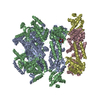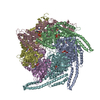[English] 日本語
 Yorodumi
Yorodumi- EMDB-8871: Cryo-EM structure of a human TRPM4 channel in complex with calciu... -
+ Open data
Open data
- Basic information
Basic information
| Entry | Database: EMDB / ID: EMD-8871 | |||||||||
|---|---|---|---|---|---|---|---|---|---|---|
| Title | Cryo-EM structure of a human TRPM4 channel in complex with calcium and decavanadate | |||||||||
 Map data Map data | membrane protein | |||||||||
 Sample Sample |
| |||||||||
 Keywords Keywords | Ion channel / MEMBRANE PROTEIN | |||||||||
| Function / homology |  Function and homology information Function and homology informationpositive regulation of atrial cardiac muscle cell action potential / positive regulation of regulation of vascular associated smooth muscle cell membrane depolarization / sodium channel complex / regulation of T cell cytokine production / membrane depolarization during AV node cell action potential / membrane depolarization during bundle of His cell action potential / membrane depolarization during Purkinje myocyte cell action potential / metal ion transport / negative regulation of bone mineralization / regulation of ventricular cardiac muscle cell action potential ...positive regulation of atrial cardiac muscle cell action potential / positive regulation of regulation of vascular associated smooth muscle cell membrane depolarization / sodium channel complex / regulation of T cell cytokine production / membrane depolarization during AV node cell action potential / membrane depolarization during bundle of His cell action potential / membrane depolarization during Purkinje myocyte cell action potential / metal ion transport / negative regulation of bone mineralization / regulation of ventricular cardiac muscle cell action potential / calcium-activated cation channel activity / sodium ion import across plasma membrane / : / dendritic cell chemotaxis / TRP channels / cellular response to ATP / positive regulation of vasoconstriction / sodium channel activity / monoatomic cation transmembrane transport / regulation of heart rate by cardiac conduction / protein sumoylation / negative regulation of osteoblast differentiation / positive regulation of insulin secretion involved in cellular response to glucose stimulus / positive regulation of fat cell differentiation / positive regulation of heart rate / positive regulation of adipose tissue development / calcium-mediated signaling / calcium ion transmembrane transport / calcium channel activity / Sensory perception of sweet, bitter, and umami (glutamate) taste / positive regulation of canonical Wnt signaling pathway / positive regulation of cytosolic calcium ion concentration / protein homotetramerization / adaptive immune response / calmodulin binding / neuronal cell body / positive regulation of cell population proliferation / calcium ion binding / endoplasmic reticulum / Golgi apparatus / nucleoplasm / ATP binding / identical protein binding / membrane / plasma membrane Similarity search - Function | |||||||||
| Biological species |  Homo sapiens (human) Homo sapiens (human) | |||||||||
| Method | single particle reconstruction / cryo EM / Resolution: 3.8 Å | |||||||||
 Authors Authors | Lu W / Winkler PA | |||||||||
 Citation Citation |  Journal: Nature / Year: 2017 Journal: Nature / Year: 2017Title: Electron cryo-microscopy structure of a human TRPM4 channel. Authors: Paige A Winkler / Yihe Huang / Weinan Sun / Juan Du / Wei Lü /  Abstract: Ca-activated, non-selective (CAN) ion channels sense increases of the intracellular Ca concentration, producing a flux of Na and/or K ions that depolarizes the cell, thus modulating cellular Ca entry. ...Ca-activated, non-selective (CAN) ion channels sense increases of the intracellular Ca concentration, producing a flux of Na and/or K ions that depolarizes the cell, thus modulating cellular Ca entry. CAN channels are involved in cellular responses such as neuronal bursting activity and cardiac rhythm. Here we report the electron cryo-microscopy structure of the most widespread CAN channel, human TRPM4, bound to the agonist Ca and the modulator decavanadate. Four cytosolic C-terminal domains form an umbrella-like structure with a coiled-coil domain for the 'pole' and four helical 'ribs' spanning the N-terminal TRPM homology regions (MHRs), thus holding four subunits in a crown-like architecture. We observed two decavanadate-binding sites, one in the C-terminal domain and another in the intersubunit MHR interface. A glutamine in the selectivity filter may be an important determinant of monovalent selectivity. Our structure provides new insights into the function and pharmacology of both the CAN and the TRPM families. | |||||||||
| History |
|
- Structure visualization
Structure visualization
| Movie |
 Movie viewer Movie viewer |
|---|---|
| Structure viewer | EM map:  SurfView SurfView Molmil Molmil Jmol/JSmol Jmol/JSmol |
| Supplemental images |
- Downloads & links
Downloads & links
-EMDB archive
| Map data |  emd_8871.map.gz emd_8871.map.gz | 265.9 MB |  EMDB map data format EMDB map data format | |
|---|---|---|---|---|
| Header (meta data) |  emd-8871-v30.xml emd-8871-v30.xml emd-8871.xml emd-8871.xml | 17.6 KB 17.6 KB | Display Display |  EMDB header EMDB header |
| Images |  emd_8871.png emd_8871.png | 238.2 KB | ||
| Filedesc metadata |  emd-8871.cif.gz emd-8871.cif.gz | 6.3 KB | ||
| Others |  emd_8871_additional.map.gz emd_8871_additional.map.gz | 19.7 MB | ||
| Archive directory |  http://ftp.pdbj.org/pub/emdb/structures/EMD-8871 http://ftp.pdbj.org/pub/emdb/structures/EMD-8871 ftp://ftp.pdbj.org/pub/emdb/structures/EMD-8871 ftp://ftp.pdbj.org/pub/emdb/structures/EMD-8871 | HTTPS FTP |
-Validation report
| Summary document |  emd_8871_validation.pdf.gz emd_8871_validation.pdf.gz | 418.2 KB | Display |  EMDB validaton report EMDB validaton report |
|---|---|---|---|---|
| Full document |  emd_8871_full_validation.pdf.gz emd_8871_full_validation.pdf.gz | 417.8 KB | Display | |
| Data in XML |  emd_8871_validation.xml.gz emd_8871_validation.xml.gz | 7.3 KB | Display | |
| Data in CIF |  emd_8871_validation.cif.gz emd_8871_validation.cif.gz | 8.5 KB | Display | |
| Arichive directory |  https://ftp.pdbj.org/pub/emdb/validation_reports/EMD-8871 https://ftp.pdbj.org/pub/emdb/validation_reports/EMD-8871 ftp://ftp.pdbj.org/pub/emdb/validation_reports/EMD-8871 ftp://ftp.pdbj.org/pub/emdb/validation_reports/EMD-8871 | HTTPS FTP |
-Related structure data
| Related structure data |  5wp6MC  8872  8875  8876  8877  8878  8879 M: atomic model generated by this map C: citing same article ( |
|---|---|
| Similar structure data |
- Links
Links
| EMDB pages |  EMDB (EBI/PDBe) / EMDB (EBI/PDBe) /  EMDataResource EMDataResource |
|---|
- Map
Map
| File |  Download / File: emd_8871.map.gz / Format: CCP4 / Size: 343 MB / Type: IMAGE STORED AS FLOATING POINT NUMBER (4 BYTES) Download / File: emd_8871.map.gz / Format: CCP4 / Size: 343 MB / Type: IMAGE STORED AS FLOATING POINT NUMBER (4 BYTES) | ||||||||||||||||||||||||||||||||||||||||||||||||||||||||||||
|---|---|---|---|---|---|---|---|---|---|---|---|---|---|---|---|---|---|---|---|---|---|---|---|---|---|---|---|---|---|---|---|---|---|---|---|---|---|---|---|---|---|---|---|---|---|---|---|---|---|---|---|---|---|---|---|---|---|---|---|---|---|
| Annotation | membrane protein | ||||||||||||||||||||||||||||||||||||||||||||||||||||||||||||
| Projections & slices | Image control
Images are generated by Spider. | ||||||||||||||||||||||||||||||||||||||||||||||||||||||||||||
| Voxel size | X=Y=Z: 1.088 Å | ||||||||||||||||||||||||||||||||||||||||||||||||||||||||||||
| Density |
| ||||||||||||||||||||||||||||||||||||||||||||||||||||||||||||
| Symmetry | Space group: 1 | ||||||||||||||||||||||||||||||||||||||||||||||||||||||||||||
| Details | EMDB XML:
CCP4 map header:
| ||||||||||||||||||||||||||||||||||||||||||||||||||||||||||||
-Supplemental data
-Additional map: membrane protein
| File | emd_8871_additional.map | ||||||||||||
|---|---|---|---|---|---|---|---|---|---|---|---|---|---|
| Annotation | membrane protein | ||||||||||||
| Projections & Slices |
| ||||||||||||
| Density Histograms |
- Sample components
Sample components
-Entire : TRPM4
| Entire | Name: TRPM4 |
|---|---|
| Components |
|
-Supramolecule #1: TRPM4
| Supramolecule | Name: TRPM4 / type: complex / ID: 1 / Parent: 0 / Macromolecule list: #1 |
|---|---|
| Source (natural) | Organism:  Homo sapiens (human) Homo sapiens (human) |
| Molecular weight | Theoretical: 540 KDa |
-Macromolecule #1: Transient receptor potential cation channel subfamily M member 4
| Macromolecule | Name: Transient receptor potential cation channel subfamily M member 4 type: protein_or_peptide / ID: 1 / Number of copies: 4 / Enantiomer: LEVO |
|---|---|
| Source (natural) | Organism:  Homo sapiens (human) Homo sapiens (human) |
| Molecular weight | Theoretical: 134.456484 KDa |
| Recombinant expression | Organism:  Homo sapiens (human) Homo sapiens (human) |
| Sequence | String: MVVPEKEQSW IPKIFKKKTC TTFIVDSTDP GGTLCQCGRP RTAHPAVAME DAFGAAVVTV WDSDAHTTEK PTDAYGELDF TGAGRKHSN FLRLSDRTDP AAVYSLVTRT WGFRAPNLVV SVLGGSGGPV LQTWLQDLLR RGLVRAAQST GAWIVTGGLH T GIGRHVGV ...String: MVVPEKEQSW IPKIFKKKTC TTFIVDSTDP GGTLCQCGRP RTAHPAVAME DAFGAAVVTV WDSDAHTTEK PTDAYGELDF TGAGRKHSN FLRLSDRTDP AAVYSLVTRT WGFRAPNLVV SVLGGSGGPV LQTWLQDLLR RGLVRAAQST GAWIVTGGLH T GIGRHVGV AVRDHQMAST GGTKVVAMGV APWGVVRNRD TLINPKGSFP ARYRWRGDPE DGVQFPLDYN YSAFFLVDDG TH GCLGGEN RFRLRLESYI SQQKTGVGGT GIDIPVLLLL IDGDEKMLTR IENATQAQLP CLLVAGSGGA ADCLAETLED TLA PGSGGA RQGEARDRIR RFFPKGDLEV LQAQVERIMT RKELLTVYSS EDGSEEFETI VLKALVKACG SSEASAYLDE LRLA VAWNR VDIAQSELFR GDIQWRSFHL EASLMDALLN DRPEFVRLLI SHGLSLGHFL TPMRLAQLYS AAPSNSLIRN LLDQA SHSA GTKAPALKGG AAELRPPDVG HVLRMLLGKM CAPRYPSGGA WDPHPGQGFG ESMYLLSDKA TSPLSLDAGL GQAPWS DLL LWALLLNRAQ MAMYFWEMGS NAVSSALGAC LLLRVMARLE PDAEEAARRK DLAFKFEGMG VDLFGECYRS SEVRAAR LL LRRCPLWGDA TCLQLAMQAD ARAFFAQDGV QSLLTQKWWG DMASTTPIWA LVLAFFCPPL IYTRLITFRK SEEEPTRE E LEFDMDSVIN GEGPVGTADP AEKTPLGVPR QSGRPGCCGG RCGGRRCLRR WFHFWGAPVT IFMGNVVSYL LFLLLFSRV LLVDFQPAPP GSLELLLYFW AFTLLCEELR QGLSGGGGSL ASGGPGPGHA SLSQRLRLYL ADSWNQCDLV ALTCFLLGVG CRLTPGLYH LGRTVLCIDF MVFTVRLLHI FTVNKQLGPK IVIVSKMMKD VFFFLFFLGV WLVAYGVATE GLLRPRDSDF P SILRRVFY RPYLQIFGQI PQEDMDVALM EHSNCSSEPG FWAHPPGAQA GTCVSQYANW LVVLLLVIFL LVANILLVNL LI AMFSYTF GKVQGNSDLY WKAQRYRLIR EFHSRPALAP PFIVISHLRL LLRQLCRRPR SPQPSSPALE HFRVYLSKEA ERK LLTWES VHKENFLLAR ARDKRESDSE RLKRTSQKVD LALKQLGHIR EYEQRLKVLE REVQQCSRVL GWVAEALSRS ALLP PGGPP PPDLPGSKD UniProtKB: Transient receptor potential cation channel subfamily M member 4 |
-Macromolecule #2: DECAVANADATE
| Macromolecule | Name: DECAVANADATE / type: ligand / ID: 2 / Number of copies: 8 / Formula: DVT |
|---|---|
| Molecular weight | Theoretical: 957.398 Da |
| Chemical component information |  ChemComp-DVT: |
-Experimental details
-Structure determination
| Method | cryo EM |
|---|---|
 Processing Processing | single particle reconstruction |
| Aggregation state | particle |
- Sample preparation
Sample preparation
| Buffer | pH: 8 |
|---|---|
| Vitrification | Cryogen name: ETHANE |
- Electron microscopy
Electron microscopy
| Microscope | FEI TITAN KRIOS |
|---|---|
| Image recording | Film or detector model: GATAN K2 SUMMIT (4k x 4k) / Detector mode: SUPER-RESOLUTION / Average electron dose: 54.0 e/Å2 |
| Electron beam | Acceleration voltage: 300 kV / Electron source:  FIELD EMISSION GUN FIELD EMISSION GUN |
| Electron optics | Illumination mode: FLOOD BEAM / Imaging mode: BRIGHT FIELD |
| Experimental equipment |  Model: Titan Krios / Image courtesy: FEI Company |
 Movie
Movie Controller
Controller











 Z (Sec.)
Z (Sec.) Y (Row.)
Y (Row.) X (Col.)
X (Col.)





























